
Uzbekistan is a landlocked country in Central Asia. It is itself surrounded by five landlocked countries: Kazakhstan to the north; Kyrgyzstan to the northeast; Tajikistan to the southeast; Afghanistan to the south, Turkmenistan to the south-west. Its capital and largest city is Tashkent. Uzbekistan is part of the Turkic languages world, as well as a member of the Organization of Turkic States. While the Uzbek language is the majority spoken language in Uzbekistan, Russian is widely used as an inter-ethnic tongue and in government. Islam is the majority religion in Uzbekistan, most Uzbeks being non-denominational Muslims. In ancient times it largely overlapped with the region known as Sogdia, and also with Bactria.
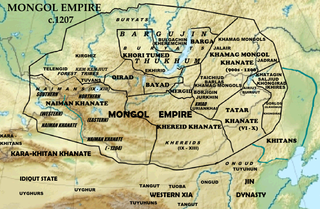
A Borjigin is a member of the Mongol sub-clan that started with Bodonchar Munkhag of the Kiyat clan. Yesugei's descendants were thus said to be Kiyat-Borjigin. The senior Borjigids provided ruling princes for Mongolia and Inner Mongolia until the 20th century. The clan formed the ruling class among the Mongols and some other peoples of Central Asia and Eastern Europe. Today, the Borjigid are found in most of Mongolia, Inner Mongolia and Xinjiang, and genetic research has shown that descent from Genghis Khan and Timur is common throughout Central Asia and other regions.
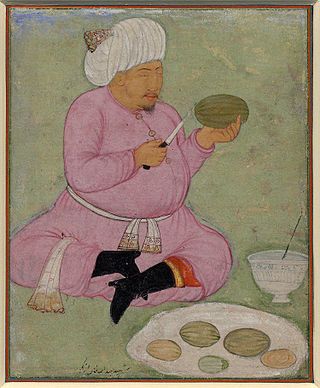
Abdullah Khan, known as "The Old Khan", was an Uzbek ruler of the Khanate of Bukhara (1500–1785). He was the last uncontested Shaybanid Khan of Bukhara from 1583 until his death.

The Khanate of Kokand was a Central Asian polity ruled by Ming dynasty of Uzbeks in the Fergana Valley centred on the city of Kokand between 1709 and 1876. Its territory is today divided between Uzbekistan, Kyrgyzstan, Tajikistan, and Kazakhstan.

The Uzbek Khanate, also known as the Abulkhair Khanate, was a Uzbek Shaybanid state preceding the Khanate of Bukhara. During the few years it existed, the Uzbek Khanate was the preeminent state in Central Asia, ruling over most of modern-day Uzbekistan, much of Kazakhstan and Turkmenistan, and parts of southern Russia. This is the first state of the Abulkhairids, a branch of the Shaybanids.
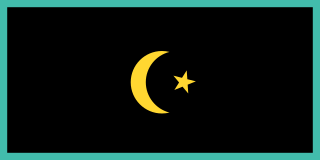
The Khanate of Khiva was a Central Asian polity that existed in the historical region of Khwarazm from 1511 to 1920, except for a period of Afsharid occupation by Nader Shah between 1740 and 1746. Centred in the irrigated plains of the lower Amu Darya, south of the Aral Sea, with the capital in the city of Khiva. It covered present-day western Uzbekistan, southwestern Kazakhstan and much of Turkmenistan before the Russian conquest at the second half of the 19th century.
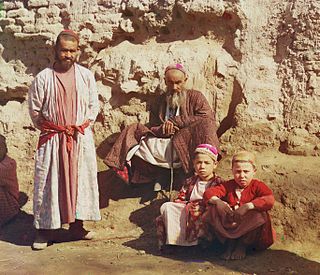
Sart is a name for the settled inhabitants of Central Asia which has had shifting meanings over the centuries. According to Great Soviet Encyclopedia, before the October Revolution of 1917, the name “Sart” was used in relation to the Uyghurs and Uzbeks by Kazakhs, Kyrgyz, and semi-nomadic Uzbeks.

The Kazakh Khanate, in eastern sources known as Ulus of the Kazakhs, Ulus of Jochi, Yurt of Urus, was a Kazakh state in Central Asia, successor of the Golden Horde existing from the 15th to the 19th century, centered on the eastern parts of the Desht-i Qipchaq.

Soviet Central Asia was the part of Central Asia administered by the Russian SFSR and then the Soviet Union between 1918 and 1991, when the Central Asian republics declared independence. It is nearly synonymous with Russian Turkestan in the Russian Empire. Soviet Central Asia went through many territorial divisions before the current borders were created in the 1920s and 1930s.
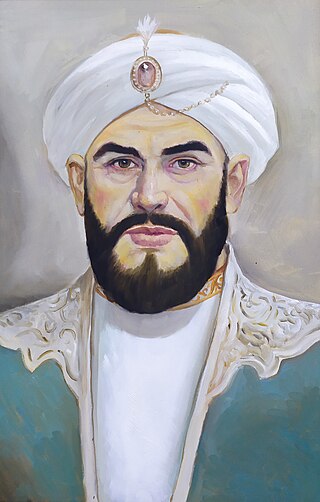
Abu al-Ghazi Bahadur was the Khan of Khiva from 1643 to 1663. He was a member of the Uzbek Shaybanid dynasty. He spent ten years in Persia before becoming khan, and was very well educated, writing two historical works in the Khiva dialect of the Chagatai language. He was a descendant of Genghis Khan through Arab Shah.

The Manghud, or Manghit were a Mongol tribe of the Urud-Manghud federation. Manghuds who moved to the Desht-i Qipchaq steppe were Turkified. They established the Nogai Horde in the 14th century and the Manghit dynasty to rule the Emirate of Bukhara in 1785. They took the Islamic title of Emir instead of the title of Khan, since they were not descendants of Genghis Khan and rather based their legitimacy as rulers on Islam. However, Persian historian Rashid-al-Din Hamadani who chronicled the Mongols, claimed that many old Mongolian clans were founded by Borjigin members. The clan name was used for Mongol vanguards as well. Members of the clan live in several regions of Central Asia and Mongolia.
A khanate or khaganate is a type of historic polity ruled by a khan, khagan, khatun, or khanum. Khanates were typically nomadic Turkic, Tatar and Mongol societies located on the Eurasian Steppe, politically equivalent in status to kinship-based chiefdoms and feudal monarchies. Khanates and khaganates were organised tribally, where leaders gained power on the support and loyalty of their warrior subjects, gaining tribute from subordinates as realm funding. In comparison to a khanate, a khaganate, the realm of a khagan, was a large nomadic state maintaining subjugation over numerous smaller khanates. The title of khagan, translating as "Khan of the Khans", roughly corresponds in status to that of an emperor.

Moghulistan, also called the Moghul Khanate or the Eastern Chagatai Khanate, was a Mongol breakaway khanate of the Chagatai Khanate and a historical geographic area north of the Tengri Tagh mountain range, on the border of Central Asia and East Asia. That area today includes parts of Kazakhstan, Kyrgyzstan, and northwest Xinjiang, China. The khanate nominally ruled over the area from the mid-14th century until the late 17th century.

Ersari are one of the major tribes of the Turkmen people of Central Asia and one of the five major tribes of the country of Turkmenistan. They live mainly in Turkmenistan, Afghanistan and Pakistan.

The Syr-Darya Oblast was one of the oblasts of the Russian Empire, a part of Russian Turkestan. Its center was Tashkent.

The Battle of Orbulaq was fought in 1643 between Jahangir sultan Khan and Huntaiji Erdeni Batur, resulting in the defeat of Erdeni Batur's army by the Jalantush Bahadur's Kazakhs, led by Jahangir Sultan with the assistance of the Uzbek Emir of Samarkand. The battle, fought during a series of Kazakh-Dzungar Wars, was one of the initial turning points in the liberation war of the Kazakhs against the Dzhungar invasion in the 17th century.

Shajara-i Tarākima is a Chagatai-language historical work completed in 1659 by Khan of Khiva and historian Abu al-Ghazi Bahadur.
Kazakh invasion of Northern Bukhara also known as a Kazakh invasion of Mā Warāʾ an-Nahr was a military campaign of the Kazakh Khanate led by Tawakkul Khan against the Khanate of Bukhara in 1598 and 1599.
Eltuzar Muhammad Bahodir Khan, was the third Inak and first Khan of the Kungrat dynasty in the Khanate of Khiva, which covered a western part of today's Uzbekistan and parts of Turkmenistan. He reigned between 1804 and 1806, when he was killed in battle.
Yalangtoʻsh Bahodir 1578, Bukhara, Bukhara Khanate - 1656, Samarkand, Bukhara Khanate), a major representative of the military-owning nobility during the Ashtarkhanid era. He belonged to the Olchin tribe of Uzbeks and served as the governor of Samarkand since 1626. Yalangtosh Bahadir was brought up under Bukhara Khan Abdulla Khan















